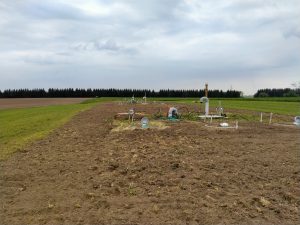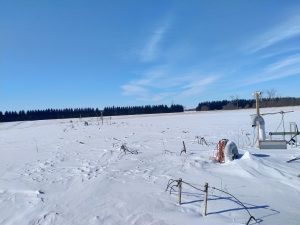HOME PREVIOUS ARTICLE NEXT ARTICLE
By: Samantha Earl-Goulet, 2021 OSCIA/OAC Soil Health Graduate Scholarship winner
In cold climates, the freezing and thawing of agricultural soils is a significant source of nitrous oxide (N2O) emissions, and therefore, a dominant contributor to global climate change1. Despite this, freeze-thaw cycle-derived N2O is commonly not included in national and global greenhouse gas budgets, resulting in an underestimation of between 17-28%2,3. The current research focuses on understanding how the production and emission patterns of N2O are influenced by increasing winter temperatures and cover crop utilization. In doing so, our ability to describe, model, and predict annual N2O emissions will increase, and new emission factors can be developed.
Global climate change is predicted to increase winter temperatures and decrease snow cover throughout Ontario. These conditions are expected to result in a shallow and discontinuous snowpack, reducing soil insulation and in turn soil temperature4. Increases in N2O emissions from croplands are expected to occur under these conditions due to freeze-thaw cycles’ enhanced frequency and severity. However, few studies have been conducted emulating how these physical and biogeochemical changes are expected to occur in field conditions. The utilization of cover crops as a nitrogen management practice has been proposed to regulate freeze-thaw cycles and N2O production under increased winter temperatures. Increasing our understanding of how N2O production and emission patterns are being altered by the changing climate, and what practices can be implemented on farms to mitigate these changes, is critical for improving greenhouse gas models and environmental policy development.

Elora Research Station, Lysimeter facility in the winter (top picture) and in the spring (above) (Samantha Earl-Goulet).
Samantha’s Ph. D research is being conducted in Ontario at the Elora Research Station Lysimeter Facility. Using 18 undisturbed soil monoliths, we are able to continuously monitor the production and emission of N2O in a highly controlled, manipulated field experiment. The study is made up of three crop rotation treatments: (i) conventional rotation, (ii) diverse rotation including cover crops, and (iii) diverse rotation with increased winter temperature conditions. Each rotation is replicated on silt loam and sandy loam soils to understand spatial variations in N2O patterns.
Preliminary results from the study have shown greater N2O emissions in sandy soils exposed to increased winter temperatures; therefore, providing the first suggestion of spatial and temporal variations in freeze-thaw N2O production mechanisms and patterns.
A poor understanding of the contribution of freeze-thaw cycles to the global flux of N2O and the spatial and temporal variations limits the team’s ability to create effective environmental policy. The research aims to improve our understanding of annual N2O emissions which can be used to update and develop new emission factors.
Samantha began this project in 2021, fresh off the plane from New Zealand. While the winters have been a shock to the system, she is enjoying the challenges of the research. She is grateful to OSCIA for their financial support and looks forward to sharing the final result of the project.
References:
- Nitrous oxide, climate change, and agriculture
- Globally important nitrous oxide emissions from croplands induced by freeze-thaw cycles. Nature Geoscience
- A gap in nitrous oxide emission reporting complicates long-term climate mitigation. Proceedings of the National Academy of Sciences
- Changes in snow cover alter nitrogen cycling and gaseous emissions in agricultural soils. Agriculture, Ecosystems & Environment
